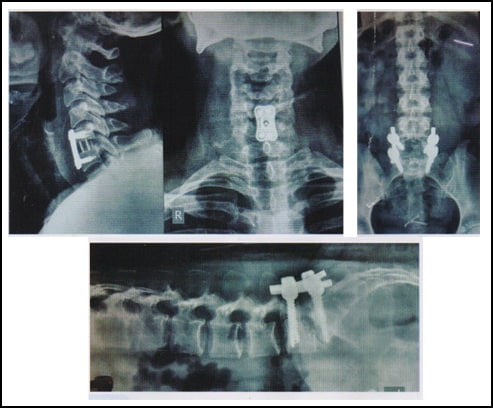Spine Surgery
What is Spine Surgery ?
Approximately 80% of people experience back pain during their lifetime. Though for the majority of these patients the pain will subside by medications and physiotherapy without the need for surgery. While, the remaining, still require a spine surgery to get rid of their back problems. Spine surgery is an invasive pain management procedure in which a specially trained doctor (the surgeon) uses instruments to make incisions to repair damaged spinal tissues. Or in other words Spine surgery whether back or neck surgery, can be sum up as an advanced treatment option for pain and disability caused by an identifiable lesion in the patient’s anatomy that has not adequately improved with non-surgical treatments.

At IO hospital, we have a dedicated team of spine surgeons who are committed to providing with the finest surgical care available today. Our team of spine surgeons and physiotherapists will work with you to make your stay at the hospital pleasant and your transition back to home as smooth as possible.
Types of Spine surgery
Microdiscectomy
A herniated disc is the most common reason for spine surgery. Micro discectomy is the preferred mode of surgery in our hospital. The operating theatre is equipped with the latest ‘Carl Zeiss’ (Germany) operating microscope.Through a small incision (1 inch) in the midline of the lower back. Under microscope visualization a small opening is made in the bony spinal canal. The prolapsed disc material compressing the nerve is identified and excised. This relieves the pain and allows for nerve function recovery.
The advantages of microdiscectomy are:
- No muscle damage or removal of bone or ligaments or damage to facetal joints resulting in post-operative instability
- Small incisions of 2-3 cms
- Less pain after Surgery
- Early mobilisation and return to home.
- Early return to work, significantly lesser complication rates and higher safety.
- Less hospital stay, lesser financial burden.
Lumbar Fixation and fusion
In this surgery we fix up teo or more vertebrae through pedicle screws and rods to provide stability to the spine and to eliminate motion between adjacent vertebrae. The spine fusion may be done because to treat a problem such as spondylolisthesis (unstable spine), or it may be done because of the extent of other surgery (such as a laminectomy).
Kyphoplasty
This is a procedure in which a special type of synthetic cement material is injected inside the broken spine bone, giving excellent results in pain relief with very low incidence of side effects. This procedure can be safely done in osteoporotic fractures, painful spine bones after spread of cancer, non cancerous painful tumors of spine bones or to augment strength of weak spine bone prior to insertion of screws to increase the holding power of the weak bones for other surgical procedures. The procedure is of short duration (30 minutes), and usually done under general or local anesthesia. Two small stitches are usually put which can be removed on an out-patient basis, ten days after the procedure. Patients are usually made to walk from the next day. The patient is discharged on the second day as most patients are pain free by then. During sitting and walking, patients have to wear a belt at least for a period of two months. Most patients return to their routine prehospital life style in a week to ten days.
Anterior cervical discectomy and fusion
This surgery is performed for variety of cervical spine problems. Generally, surgery may be performed for degenerative disorders, trauma or instability. These conditions may produce pressure on the spinal cord or on the nerves coming from the spine. The goal of this surgery is to relieve pain, numbness, tingling and weakness, restore nerve function and prevent spinal abnormal motion. Through a small incision on the front of the neck , the spine is accessed. Under microscope visualization the disc material compressing the nerve is removed. This relieves the pain and allows the nerve to regain its normal function. The empty disc space is filled with bone graft to achieve fusion (joining) between the vertebrae. The vertebrae is fixed using a plate.
Endoscopic Spine Surgery
This is an operation on the lumbar spine performed using a surgical endoscope and microsurgical techniques. This refers to the use of specialized video cameras and instruments which are passed through small incisions (less than 2 cm) into the chest, abdominal or joint cavities to perform surgery.Endoscopic spine surgery reduces spine trauma, prevents iatrogenic problems and preserves spinal segmental motion and stability. The most compelling benefits of endoscopic spine surgery over open surgery are smaller incisions and less tissue trauma, less postoperative pain, minimal blood loss and earlier return to normal work routine.
Spinal Disc Replacement
Artificial disc replacement offers a reversible, viable alternative to fusion that possibly avoids the accepted shortcomings of fusion. By inserting an artificial disc instead of performing spinal fusion, there is the possibility of reducing damage to nearby discs and joints. This is because artificial disc replacement allows for motion preservation, near normal distribution of stress along the spine and restoration of pre-degenerative disc height. Several artificial disc replacements for both the neck (cervical) and back (lumbar) spine are currently being offered to appropriate patients.
